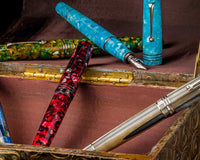When looking at the parts of a fountain pen, it is often the nib that gets the most attention. This is no surprise. After all, it is the nib that is responsible for a smooth writing experience, whether you prefer hard steel nibs or those with a little softness and flex.
However, it’s important not to gloss over other components of the fountain pen. The nib may be the pen’s star, but it would be nothing without the feed. The feed connects the nib with your fountain pen’s ink reservoir. Not only does it allow ink to flow to your nib in a “controlled leak” fashion, but it also regulates how much air flows back up to the reservoir to replace the lost ink.
Not all fountain pen feeds are the same. Here, we’ll look at some differences and determine which feeds are better for certain nibs.
How does a feed work?
A fountain pen feed is the part that sits right under the nib and supplies it with ink from inside the pen. For a feed to work properly, it must sit flush against the underside of the nib. Feeds contain one or several ink channels to draw ink from, and the nib’s slit draws the ink from the feed to its tip so that you can write with it. Most feeds have grooves or fins that hold excess ink and regulate its flow.
Types of fountain pen feeds
There are different types of fountain pen feeds, and these may be better suited for various types of nibs.
Ebonite Feeds
If you’re the kind of writer who prefers wetter nibs, then it is best to look for a pen with an ebonite feed. This semi-porous type of feed allows for better capillary action of the ink, leading to an improved flow.
Ebonite feeds can also be made more malleable with heat setting. This process softens the hard rubber, allowing it to conform to adjacent pieces such as the nib, nib collar, and the section. The result is an increase in the efficiency of capillary action. These types of feeds can also be sanded, milled or bent to further increase or decrease ink flow.
However, do bear in mind that because ebonite feeds are hand cut and finished, they are also subject to quality issues. This process also makes them more expensive.
Plastic feeds
Most pens today use plastic feeds, which have come a long way and are now designed with specific properties that make it possible to promote better ink flow. These feeds also have near-perfect air compensation, thanks to the precision and quality control of mass production.
Plastic feeds are made to have a very smooth and polished surface because they are injection molded. This lack of porosity means that they may not flow as well as in an ebonite feed. However, modern feed manufacturers have used various methods to combat these deficiencies.
How does the type of feed design affect the pen?
Owners of vintage fountain pens may notice that their writing runs a bit wet, thanks to the ebonite feed. However, these pens are also a bit more finicky as ebonite nibs don’t cope as well with temperature changes. Ink flow may also be more erratic when the pen is nearly empty.
Plastic feeds, on the other hand, deliver a more consistent quality of performance for fountain pen writers. Writers who prefer wetter pens may also choose other ways to get the same effect. For instance, they can use a better flowing ink such as the Jentle inks from Sailor. It also helps to use a wider nib to encourage more ink flow.
Which feed is better for my fountain pen nib?
Ultimately, there is very little difference between ebonite and well-made plastic feeds today. If you want to ensure a wetter flow with your larger nibs, then perhaps an ebonite feed is the way to go if you can find it. Otherwise, it is a safe bet to go with either option, no matter what nib you have.
Happy writing!
By Some Folks at EndlessPens






3 comments
jim
I am in need of a nib holder, feeder, and Sac size is no. 16, end of barrel body has 3/8 inch opening. Any help appreciated to find these parts for my Dad’s 1940 ish lever pen.
Jose Ramos
Hi, If I sent you a Signum Nova pen, 18K medium nib, I wonder if you might find a way to match the feed, or stop the pen from leaking. Do you do that type of work?
Jose Ramos
Hi, If I sent you a Signum Nova pen, 18K medium nib, I wonder if you might find a way to match the feed, or stop the pen from leaking. Do you do that type of work?